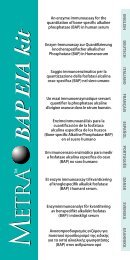Clinical and Technical Review - Tecomedical
Clinical and Technical Review - Tecomedical
Clinical and Technical Review - Tecomedical
You also want an ePaper? Increase the reach of your titles
YUMPU automatically turns print PDFs into web optimized ePapers that Google loves.
Bone Resorption<br />
Osteoclast:<br />
Large motile, multinucleated bone cell located on bone surfaces.<br />
Responsible for the resorption of bone matrix (osteoid).<br />
Osteoclasts have a ruffled border of the cell membrane that<br />
is surrounded by an organelle-free region, or « clear zone ».<br />
Mineral Dissolution:<br />
These processes take place beneath the ruffled border<br />
<strong>and</strong> depend on lysosomal enzyme secretion <strong>and</strong> an acid<br />
microenvironment. A pH gradient across the ruffled<br />
membrane is the consequence of active transport<br />
mechanisms by the osteoclasts.<br />
Collagen degradation:<br />
Osteoclasts actively synthesize lysosomal enzymes,<br />
in particular the tartrate resistant isoenzyme of acid<br />
phosphatase (TRAP 5b) <strong>and</strong> cysteine-proteinases such<br />
as Cathepsin K that are capable of degrading collagen.<br />
Two bone collagenolytic pathways exist:<br />
1. A Cathepsin K collagen degradation pathway is the prevailing<br />
one. Resulting in the following epitopes:<br />
CTX, NTX, DPD <strong>and</strong> PYD.<br />
2. A Matrix MetalloProteinase (MMP) collagen degradation<br />
pathway resulting in the epitope ICTP. This pathway becomes<br />
significant in some situations, including metastatic<br />
bone diseases <strong>and</strong> multiple myeloma. ICTP however, has<br />
proven to be a very poor marker in osteoporosis.<br />
Proteins<br />
TRAP 5b:<br />
The active isoform of TRAP5b, serum b<strong>and</strong> 5 tartrateresistant<br />
acid phosphatase, is specifically synthesized<br />
by bone-resorbing osteoclasts. It has been shown that<br />
TRAP5b catalyzes the formation of reactive oxygen<br />
species (ROS). Research results indicate that ROS<br />
generated by TRAP5b are involved in the degradation<br />
of bone matrix products in resorbing osteoclasts.<br />
TRAP5b activity reflects the osteoclast activity <strong>and</strong> is associated<br />
with the number of osteoclasts. TRAP5b is consideredamarkerfortherateofboneresorption<strong>and</strong>maybeof<br />
particular importance for patients with renal failure because<br />
- in contrast to other marker of resorption -<br />
TRAP5b does not accumulate in the blood.<br />
In tumor patients TRAP5b is an indicator for increased bone<br />
resorption due to bone metastases. Changes in TRAP<br />
activity during therapy monitoring allow the assessment of<br />
the efficiency of antiresorptive therapies in osteoporotic<br />
patients.<br />
RANK:<br />
Osteoclastic receptor for sRANKL, the main stimulatory factor<br />
for the formation of mature osteoclasts.<br />
Cathepsin K:<br />
Main osteoclastic protease, responsible for bulk degradation<br />
of Type I Collagen. Acts both intra- <strong>and</strong> extra-cellularly.<br />
Lysosomal enzymes:<br />
Enzymes secreted by the osteoclasts, responsible for<br />
mineral dissolution in an acid environment.<br />
MMP:<br />
Matrix metalloproteinases MMP-2, -9, -13, -14 participate in<br />
the degradation of the collagenous bone matrix,<br />
resulting in epitope ICTP.<br />
Calcitonin receptor:<br />
Osteoclastic receptor for calcitonin, an inhibitor of<br />
osteoclasts activity.<br />
Sclerostin:<br />
Sclerostin is the protein product of the SOST gene, which is<br />
located at 17q12-21 <strong>and</strong> highly conserved across vertebrate<br />
species.<br />
The highest expression of sclerostin throughout the adult<br />
skeleton has been observed in hypertrophic chondrocytes<br />
<strong>and</strong> osteocytes. Sclerostin belongs to the DAN1 family of<br />
glycoproteins of which multiple family members antagonize<br />
bone morphogenetic protein (BMP) <strong>and</strong>/or Wnt2 activity.<br />
Sclerostin blocks canonical Wnt signaling by binding to the<br />
Wnt coreceptors LRP5/63 . Thus, it inhibits bone formation<br />
by regulating osteoblast function <strong>and</strong> promoting osteoblast<br />
apoptosis. By blocking the Wnt-pathway Sclerostin also<br />
antagonises bone morphogenetic protein action e.g. osteoblast<br />
differentiation, but does not inhibit direct BMP-induced<br />
responses.<br />
Sclerostin expression is down-regulated by Parathyroid hormone<br />
(PTH) as well as the mechanical stimulation of bone<br />
reduces the expression of sclerostin.<br />
1 DAN = differential screening-selected gene aberrative in neuroblastomaa<br />
2 Wnt = wingless Proteine<br />
3 LRP = low-density lipoprotein receptor-related protein 5 <strong>and</strong> 6<br />
5



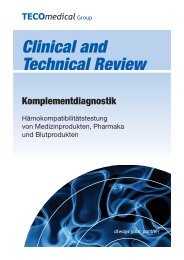
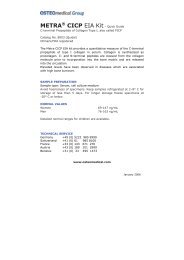
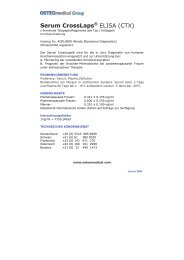
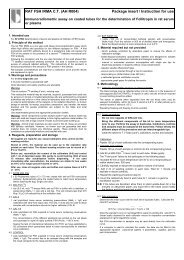


![PTH [Hormone Parathyroïdienne] Intacte ELISA](https://img.yumpu.com/1233682/1/190x245/pth-hormone-parathyroidienne-intacte-elisa.jpg?quality=85)
